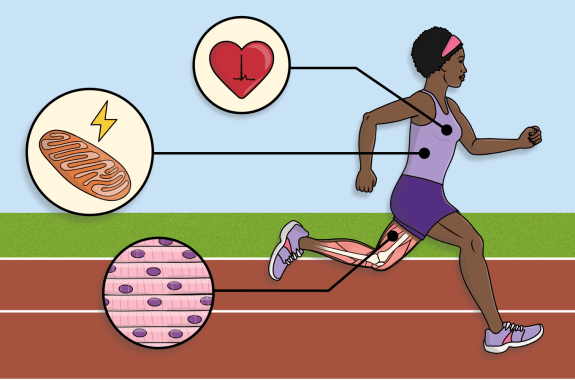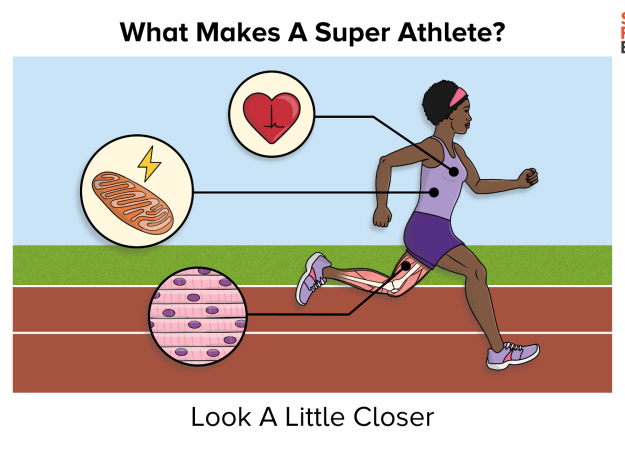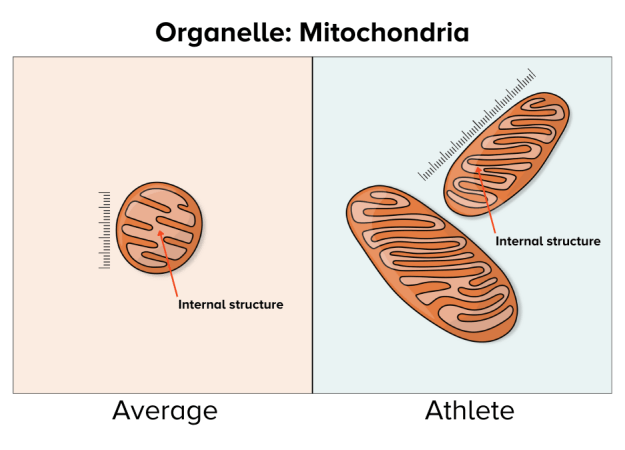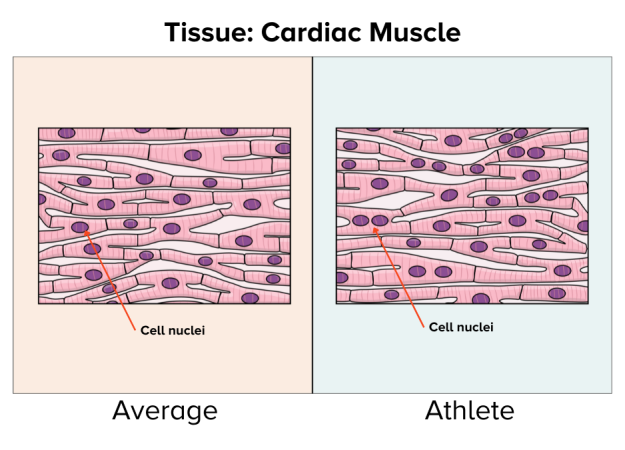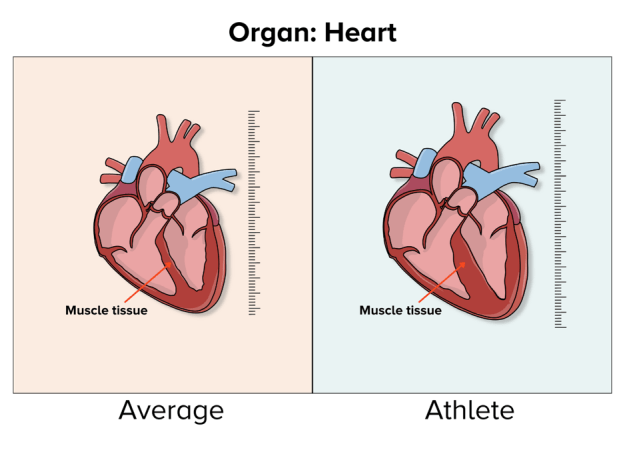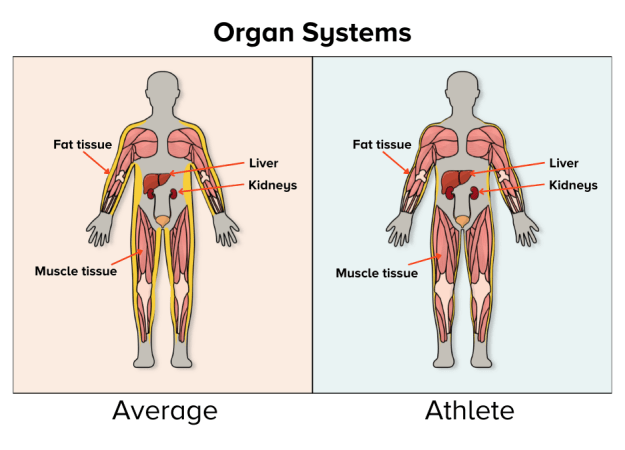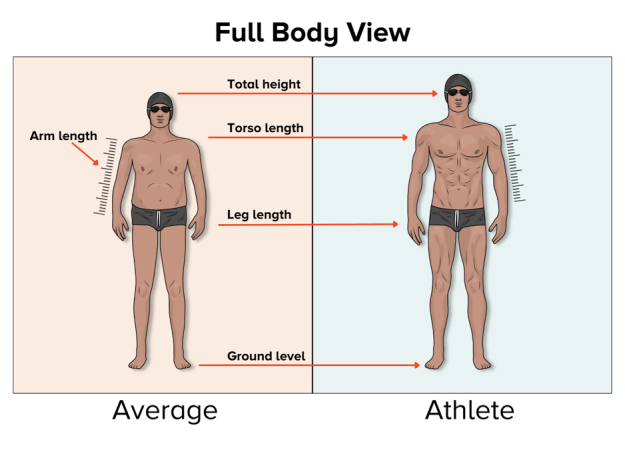Grade Level
6 - 8
minutes
Multi-day
subject
Life Science
stem practices
Constructing Explanations and Designing Solutions
Activity Type:
cell structure and function, physiology, athletics
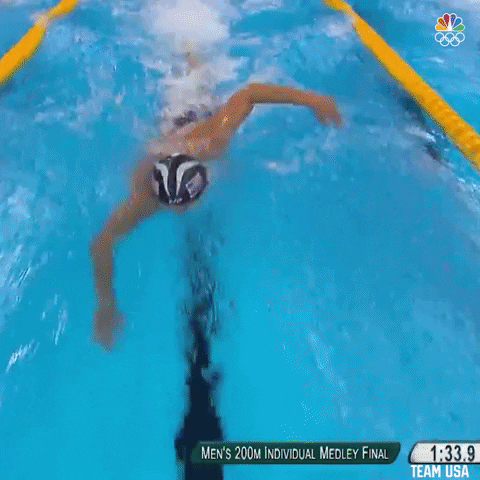
The GIF above shows Michael Phelps swimming in the 200m Individual Medley at the 2016 Olympics. He is the most decorated Olympian of all time, and his world records remain unbeaten in four individual swimming races. Is there something special about Phelps’s body that makes him such a successful swimmer? Or is anyone capable of swimming that fast, if they just put their mind to it? What does it take to become a super athlete like Phelps?
Watch the first 54 seconds of the video below, The Tarahumara – A Hidden Tribe of Superathletes Born to Run.
Now, consider the following questions:
- What questions come to mind as you compare and contrast this individual “super athlete” with an entire community of super athletes?
- Is there something different about the bodies of these athletes that make them capable of running extreme long distances, or can anyone become a super athlete?
- What do you already know about the human body and sports that may help you answer these questions? What more do you need to know?
In this series of activities, you’ll compare the physiology and abilities of athletes of different genders, races, ethnicities, and sports in order to draw conclusions about what it takes to be (or become) a super athlete. Is there something on the cellular level that makes them superior? What about their tissues or organs? How do all of these elements work together to enable these athletes to excel in their sport? Is it simply an enormous amount of training and dedication, or is it something special about how their body works that is unique to them?
Then you’ll design the next super athlete for your favorite sport. Will your super athlete cross the finish line first? Score the winning Super Bowl touchdown? Climb an “impossible” route? What specialized cells, tissues, or organs will you give them that will help them to outperform their competitors?
Activity 1: What Makes A Super Athlete?
Take a look at some of the current evidence that supports that super athletes have physical advantages by reading the article “The Secret Formula for Becoming an Elite Athlete” and watching this video. Based on this research, how would you answer the question, “What makes a super athlete?” Does luck have anything to do with it? And what more do you need to know to fully answer the question?
Activity 2: Look A Little Closer
Is it possible that no amount of practice hours will ever be enough? Is there something about their bodies that is unique to elite athletes? In this activity, you will compare average and athletic body features to determine similarities and differences. As you do, record your observations and ideas in this graphic organizer or in a science notebook. When you are done, view the slideshow (see presenter’s notes in download or view slideshow below) to check your observations and learn more about the science behind the athlete.
Let’s explore starting at the cellular level. Mitochondria are organelles inside of cells responsible for turning the energy we get from our food into energy a cell can use. The size and number of mitochondria in a cell can vary from cell to cell and person to person. Take a look at the illustrations of mitochondria from a typical person and compare them to the illustration of mitochondria from an elite athlete. How are they similar? How are they different? How might the differences be beneficial to a superathlete?
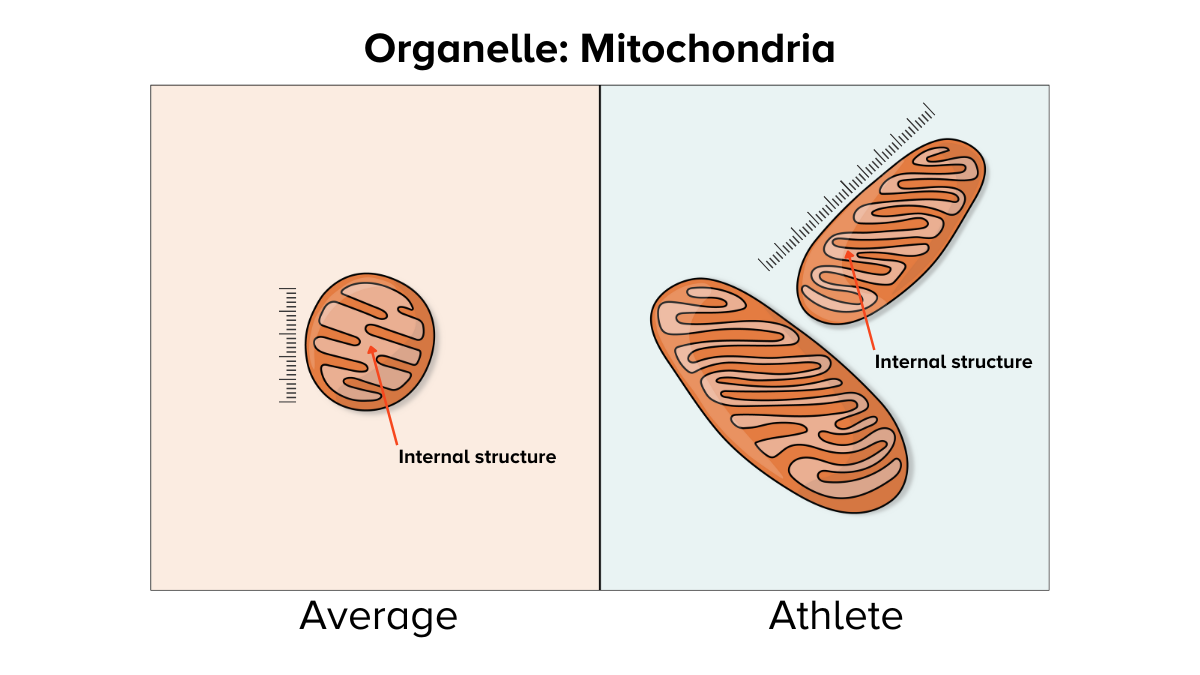
A great deal of athleticism depends on a healthy and strong heart that can efficiently pump oxygen-rich blood and nutrients to the skeletal muscles. Muscles in the arms and legs need oxygen to make energy. So a strong heart provides other muscles with what they need to react quickly, strongly, and for a longer period of time.
Examine these two cardiac (heart) muscle tissues below. The first is from the heart of an average person. The second is from an elite athlete. What differences do you notice? The purple spots are nuclei. Nuclei are organelles that function like the command center for the cell. They control everything that happens in the cell, including replication—when the cell makes more cells like itself. What conclusions, if any, can you draw about the heart tissue of elite athletes compared to the majority of the population?
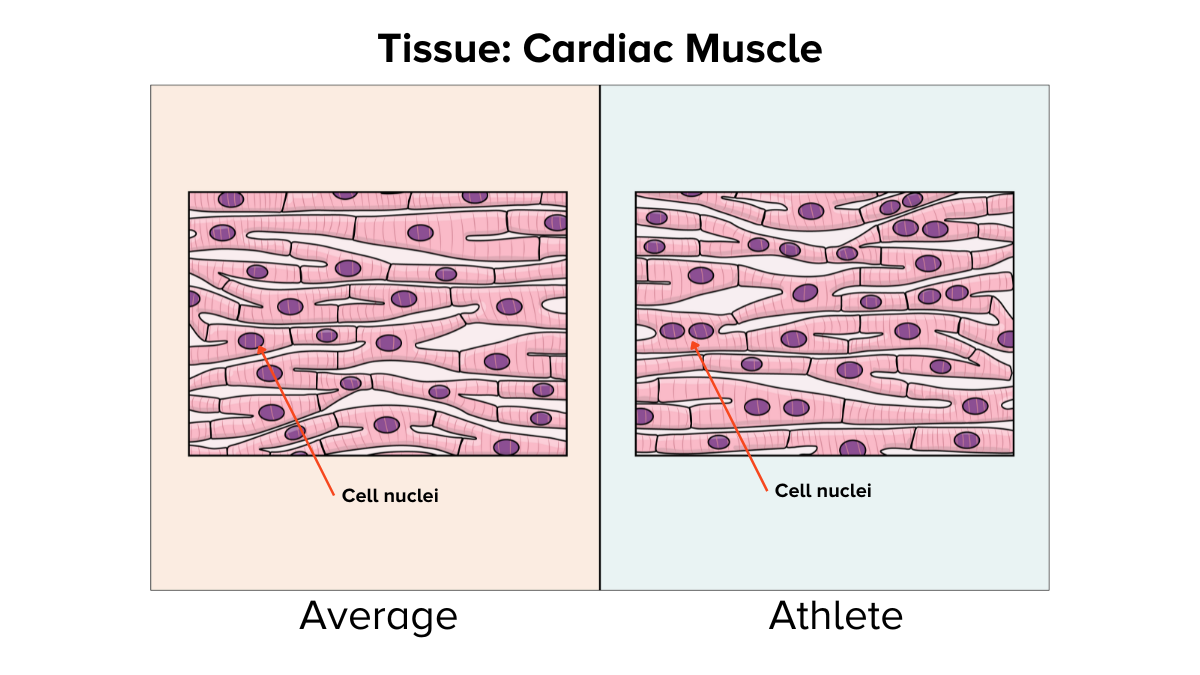
Zoom out to consider the heart as a full organ. Athletes have differences in their heart muscle that affect the strength of their hearts and enhance their ability to pump blood and oxygen throughout their bodies. The heart is mostly made of cardiac muscle, and exercise affects it much as it does skeletal muscle. The more exercise it gets, the more mass it builds and the more strength it has. What differences do you notice between an average heart and an athlete’s heart?
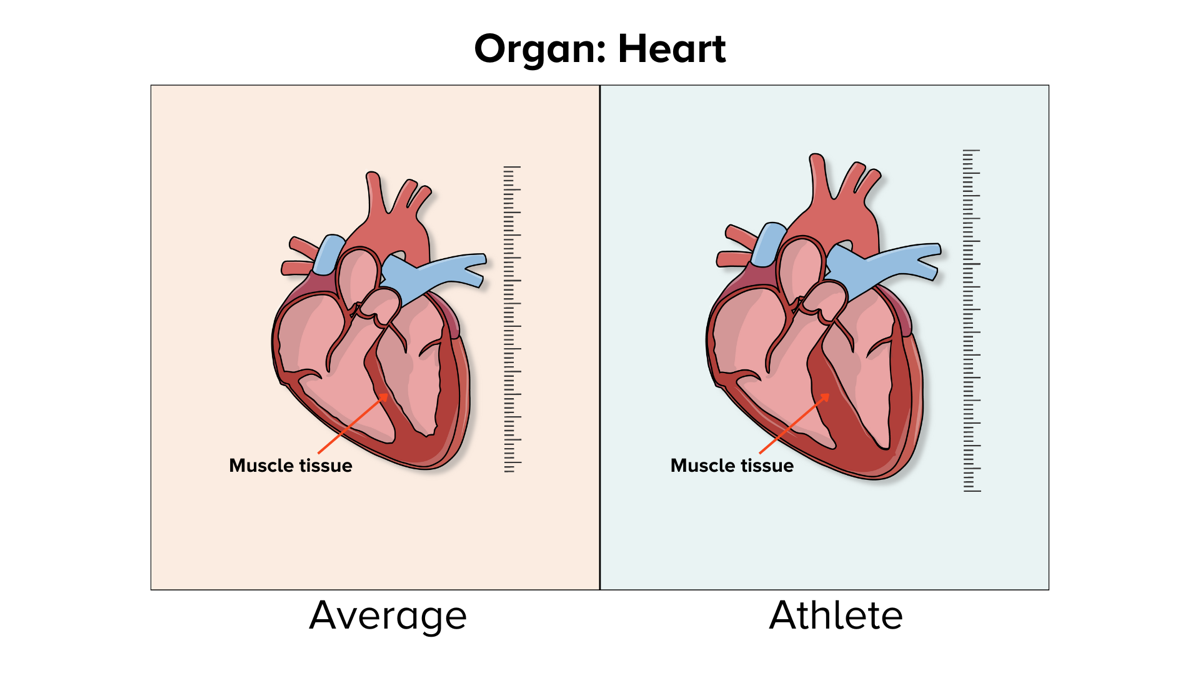
Let’s zoom out again. What are the differences at the level of organ systems? How are different types of soft tissue affected? How may the organs themselves be affected? Review the two images below of the athlete and the nonathlete. What do you notice? What aspects of the athlete’s body systems might contribute to their athletic success? You may want to do some research on the functions of different organs if you are not already familiar.
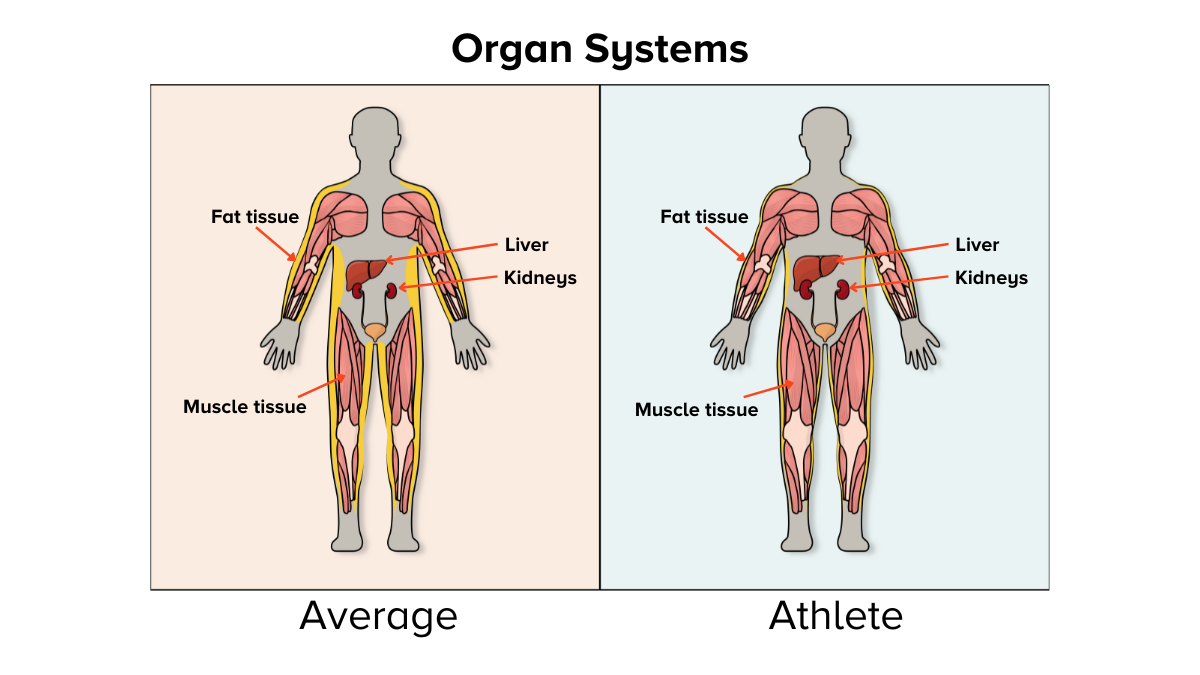
Take a look at the full body view of an average person as compared to a swimmer like Michael Phelps. What do you notice? How does his body set him up for success as an elite swimmer? It’s not just muscles. Look at his overall body proportion and features. Based on his body features, do you think he could also be an elite basketball player? Runner? Dancer? Why or why not?
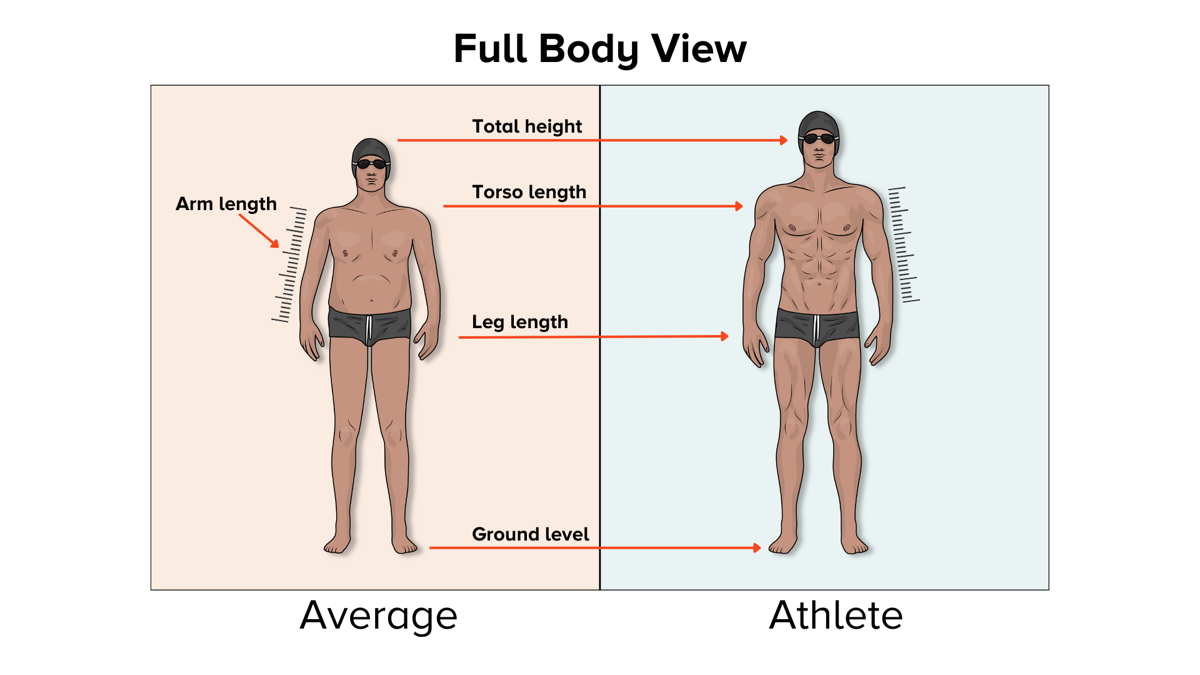
Based on your observations, what would you add (or remove) from your answer to the question, “What does it take to be a super athlete?”
Activity 3: Examine Some Examples
It probably comes as no surprise that Michael Phelps’s body shape is a great fit for his success as a swimmer. What physical qualities might other athletes have that give them an edge in their sports? Take some time to research several elite athletes in a variety of sports. Start with this list and add your favorite elite athletes. Be sure to research a wide range of athletes across several sports.
Record any information that you learn about how each athlete’s body is uniquely prepared to excel in their sport. Consider special qualities at the following levels of organization of the body:
- Cellular
- Tissue
- Organ
- Organ System
- Body Shape/Structure
Record your findings in a chart in a science notebook or in this graphic organizer so that you can easily make connections and draw conclusions.
Once you have completed your research, take a look at your notes. How would you answer the following questions?
- What commonalities do you notice between different athletes?
- What are some examples of body parts or specific qualities that give an advantage in certain sports? Do these qualities provide advantages across all sports? Why or why not?
- What other connections or conclusions can you make from your findings?
- How does your research change or add to your answer to the question, “What does it take to be a super athlete?”
Activity 4: Super Athlete Brainstorm
What would it take to be a super athlete in your favorite sport? If you could design a super athlete from scratch, what qualities would you give them? You can’t really design a super athlete in the real world, but it might be fun to imagine one! Brainstorm the qualities and attributes you would give to your super athlete. You may find it helpful to create a concept map similar to the one shown below. Be sure to describe the cell qualities, tissue characteristics, organs, systems, and body traits for your athlete. How will all of these different aspects of your athlete work together to take them from athletic to superstar?
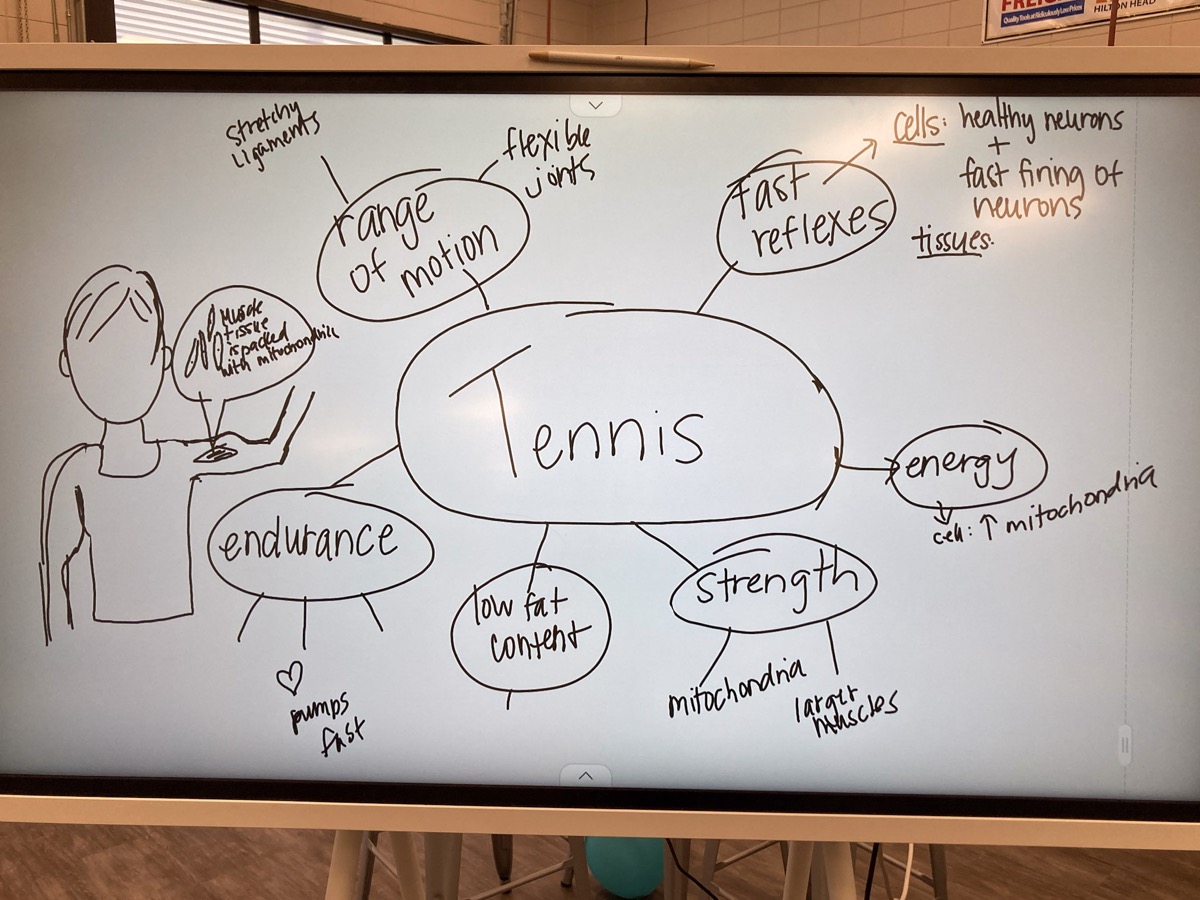
Activity 5: Body Systems Tie It All Together
How will your athlete’s body systems work together to create each of the attributes for your super athlete? For example, Michael Phelps’s arms are longer than that of an average human. What body systems work together to achieve longer-than-average arms? Answer this question for each of the super athlete characteristics that you brainstormed in Activity 4, and explain how your athlete’s body systems will work together to develop each quality.
Will your athlete need endurance? Check out this Science Friday interview, A Tiny Training Partner In Your Gut? for some fun ideas to add to your super athlete.
For each characteristic of your athlete, list the following in your science notebook:
- Claim: Answer the question, “How will your athlete’s body systems work together to create this attribute?”
- Evidence: Support your claim with evidence from your research and past knowledge.
- Reasoning: Explain how or why your evidence supports your claim.
Review the Claims, Evidence, Reasoning (CER) rubric to complete this activity. As you elaborate on your ideas, go back and add details to your concept map from Activity 4. The more ideas you have down on paper, the more prepared you will be for the final step.
Activity 6: Model It!
Create an illustration to show off your super athlete. You can use this blank human body organizer as a first draft to sketch out the internal structures of your specimen on one side, as well as the external physical features on the other side. Then transfer your images and ideas to a posterboard or a virtual poster and elaborate with additional images and words to fully explain your ideas. For example, if you draw an athlete with large muscles, include a sketch off to the side to show what the tissue or cells look like in your super athlete. Include short statements to explain how the cells or tissue make the muscles larger or work harder. The poster should showcase how your athlete is unique and the GOAT (Greatest of All Time).
Share your super athlete with others! What do they think? Do they agree that your athlete will excel at their sport?
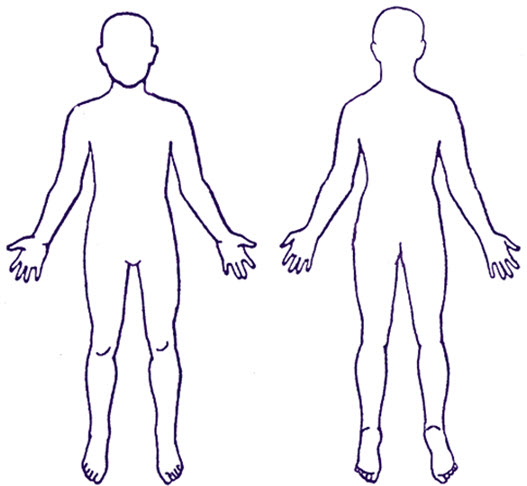
Extensions: Next Level Linkouts
Science is still figuring out everything that goes into the qualities and characteristics necessary for an athlete to be the best of the best. Check out these Science Friday interviews to learn even more about the science of elite athletics:
Next Generation Science Standards
This resource works toward the following performance expectations:
- MS-LS1-3: Use argument supported by evidence for how the body is a system of interacting subsystems composed of groups of cells.
- MS-LS1-5: Construct a scientific explanation based on evidence for how environmental and genetic factors influence the growth of organisms.
- MS-LS3-1: Develop and use a model to describe why structural changes to genes (mutations) located on chromosomes may affect proteins and may result in harmful, beneficial, or neutral effects to the structure and function of the organism.
Credits
Lesson by Emily Courtenay and Lauren Avant
Illustrations by Nekane Terrades Garcia
Draft Development by Xochitl Garcia and Sandy Roberts
Developmental Editing by Tina Kapler
Copyediting by Cybele Tamulonis and Ariel Zych
Digital Production by Sandy Roberts
Educator's Toolbox
Meet the Writers
About Emily Courtenay
Emily Courtenay is a 7th-grade STEAM Life Science teacher at Richmond Hill Middle School.
About Lauren Avant
Lauren Avant is a 7th-grade STEAM Life Science teacher at Richmond Hill Middle School.
